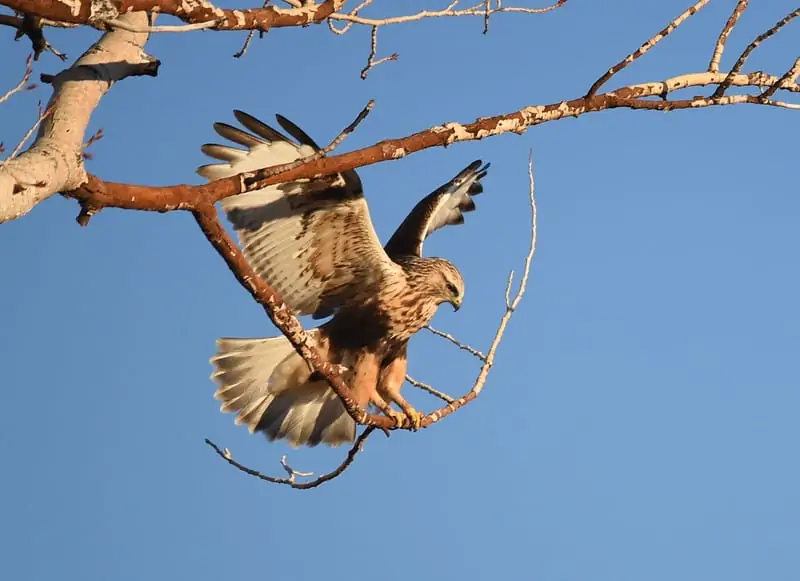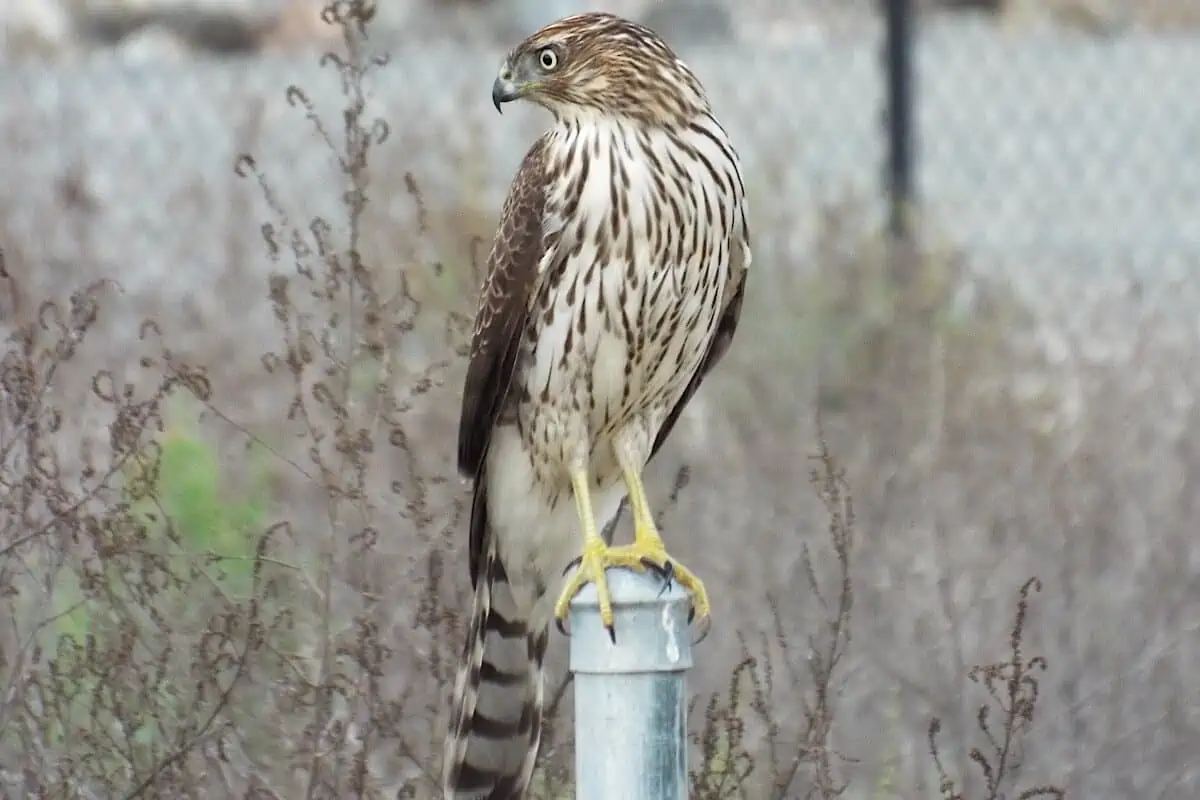Hawks belong to the birds-of-prey family, which includes carnivorous birds. Their acute hearing and vision, as well as their razor-sharp beak and talons, help them to make outstanding predators. In the United States, there are around 16 different kinds of hawks. The eight species of hawks found in Indiana, however, will be discussed in this article.
8 HAWKS IN INDIANA
The broad-winged hawk, Coopers hawk, northern goshawk, northern harrier, red-tailed hawk, red-shouldered hawk, rough-legged hawk, and sharp-shinned hawk are the eight species of hawks found in Indiana.
Let’s take a look at each one.
1. BROAD-WINGED HAWK

Scientific name: Buteo platypterus
Length: 13.4-17.3 in
Weight: 9.3-19.8 oz
Wingspan: 31.9-39.4 in
During the breeding season, broad-winged hawks are migratory and only travel north into Indiana. The head and breast of these little hawks are brown, with barred underparts and black and white stripes on their tail. Their short tail and large wings with sharp tips are visible in the air.
During the breeding season, these hawks prefer to be alone. Far from humans, they will nest in woods and beside bodies of water. Little animals, insects, and amphibians like frogs and toads make up the majority of their diet.
The best time to spot the broad-winged hawk is during their return migration from South America in the fall. Flocks of hundreds of birds circle in the sky, called “kettles.” You can see them in the woods if you are not in their migration path. Listen for their harsh whistles.
2. COOPERS HAWK

Scientific name: Accipiter cooperii
Length: 14.6 – 17.7 in
Weight: 7.8 – 24.0 oz
Wingspan: 24.4-35.4 in
Cooper’s hawks may be seen all year round in Indiana, and can be found across most of North America. Adults have a red eye, squared-off head with a black hat, and a blue-gray back with strong orange barring on the chest. The eyes of immature birds are yellow, the back is brown, and the underparts are white with thick brown streaks.
They seem to be fairly comfortable in the suburbs, as well as forests and woodlands. Little birds are their primary source of food, and they hunt them in the tree canopy with ease. Cooper’s hawks have been known to attack birds at a bird feeder, particularly starlings, doves, and pigeons, and many people encounter them in their backyard.
During a high-speed chase after birds, crashing through trees and foliage takes a toll, and Cooper’s hawk skeletons show that many of them had previously fractured bones in their chest.
3. NORTHERN GOSHAWK

Scientific name: Accipiter gentilis
Length: 20.9-25.2 in
Weight: 22.3-48.1 oz
Wingspan: 40.5-46.1 in
The back of a goshawk is gray, and the chest has a wide stripe that runs down the belly. Each eye has a thick stripe. They’re considerably bigger and tougher than sharp-shinned and cooper’s hawks, respectively. Goshawks, on the other hand, are quite secretive and prefer to stay in the forest, avoiding human-populated areas.
Little hawks, birds, mammals, reptiles, and even insects and carrion make up the northern goshawk’s varied diet. Because of their secretive nature, they are considered uncommon, and the population is difficult to estimate.
In Indiana, these hawks are rather uncommon, however during the non-breeding winter months, they may be seen from time to time. Hares and grouse travel farther south than usual into the United States in certain years when their northern habitat is sparse. They’re looking for food, in particular.
4. NORTHERN HARRIER

Scientific name: Circus hudsonius
Length: 18.1-19.7 in
Weight: 10.6-26.5 oz
Wingspan: 40.2-46.5 in
The face of the northern harrier is almost owl-like. This disc-shaped face, like that of an owl, directs sound into the ears of these creatures so that they may locate prey by both sight and sound. Their long tail and white patch above the tail are two helpful identifying characteristics. They hold their wings in the shape of a “V” and have a distinctive flying style. These birds are described as majestic by many people.
This hawk can be found year-round in Indiana. Marshes, fields, and other large open spaces are where you’re most likely to see them.
This hawk creates a platform on the ground in thick vegetation, such as reeds, willows, sedges, and cattails, unlike many hawks that nest in trees. Males may have two (sometimes more) partners at once, and the female and her kids will be fed by them.
5. RED TAILED HAWK

Scientific name: Buteo jamaicensis
Length: 17.7 – 25.6 in
Weight: 24.3oz – 51.5 oz
Wingspan: 44.9-52.4 in
The most prevalent hawk on the continent of North America, red-tailed hawks may be found in practically every state, including Indiana. During the winter, birds that have spent their summer in Canada descend to join the others in the United States, allowing their population to grow even more.
The red-tailed hawk is frequently seen soaring with its amazing vision or perched along the roadway on telephone poles, and is most active during the day or early morning. Little to medium-sized creatures such as mice, rats, rabbits, and squirrels make up the majority of their diet. Birds and snakes are also possible meals.
The tail of an adult is brick-red, whereas that of a juvenile is brown and white striped. It’s simple to differentiate between the two. These hawks are mostly dark brown above and pale below. Their breast is streaked with brown, and a dark brown stripe across their belly region is another distinguishing characteristic. There are numerous color variations throughout the nation since these hawks are so widespread.
The red-tailed hawk produces a long wailing scream that has come to symbolize all raptors. Their cry is usually employed as the sound for any hawk or eagle seen on film in movies and TV.
6. RED-SHOULDERED HAWK

Scientific name: Buteo lineatus
Length: 16.9-24.0 in
Weight: 17.1-27.3 oz
Wingspan: 37.0-43.7
In their range, which stretches from eastern North America to Mexico, red-shouldered hawks may be found. The state of California and its western shore. They’re still around all year in Indiana.
The thick red coloring on the breast, which extends down their tummy with crimson stripes, is a great identifying feature. Down their backs and wings, they have black feathers that are practically black. This will be combined with reddish feathers (hence their name) at the top of their back and shoulders. There will be a lot of white barring mixed in with the black feathers, which will culminate in a heavily banded tail, from the mid-back down.
These hawks prefer flooded areas and wetlands, where they live and hunt in the forest. Suburban regions with woods mingling with buildings are also good places to look for them. Although they look a lot like red-tailed hawks, when you know the distinctions, it’s easier to tell them apart.
7. ROUGH-LEGGED HAWK

Scientific name: Buteo lagopus
Length: 18.5-20.5 in
Weight: 25.2-49.4 oz
Wingspan: 52.0-54.3 in
During the autumn and winter months, rough-legged hawks may be seen in Indiana. They trek all the way to the northern Arctic when it comes time to move to their breeding grounds! They’ll build nests on cliffs and rocky outcrops there.
You may see them in the wide-open prairies of the winter, perched on poles and fence posts. Mice, voles, and shrews are among the animals they pursue. To gain a hover-in-place position from which to scan the ground below them for prey, rough-legged hawks are known to turn into the wind and flap their wings.
The feathers on the legs of rough-legged hawks give them their name. Feathers that go all the way down a raptor’s legs are uncommon in the United States. The majority have a thick black belly patch and are heavily mottled dark brown and white. As the “wrist” against a light backdrop, you’ll notice a black patch in the air. A dark-morph looks like it’s two-toned from below and appears nearly black.
8. SHARP SHINNED HAWKS

Scientific name: Accipiter striatus
Length: 9.4-13.4 in
Weight: 3.1-7.7 oz
Wingspan: 16.9-22.1 in
The smallest hawk in the United States, sharp-shinned hawks live in Indiana year-round and are the only ones. Little birds and rodents are prey for these hawks, which pursue them through the woods.
They stick to woodlands with thick canopy when nesting, making them difficult to locate. Backyard visits to hunt birds at feeders are not uncommon. During the fall migration, however, is when you’ll catch them. They go south, towards the United States. They are frequently seen at hawk watch sites and in their summer range in Canada.
The backs of Sharp-shinned Hawks are blue-gray, with reddish-orange streaking on the chests and dark banding on their tails. With a more rounded head and squared-off tail, they resemble cooper’s hawks greatly.
